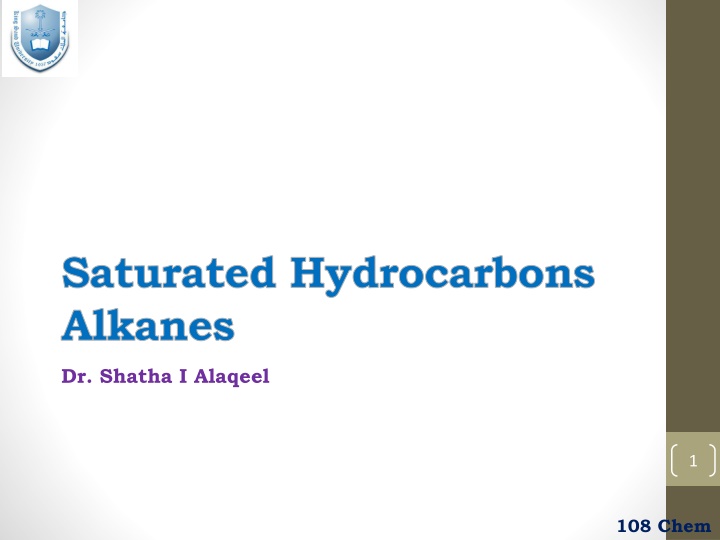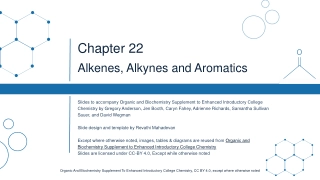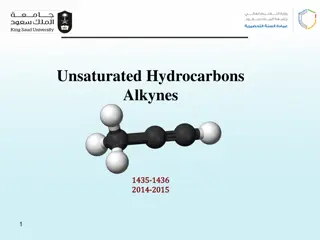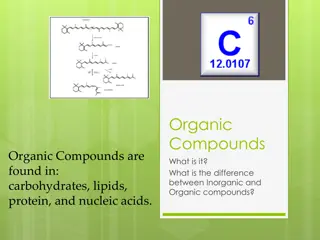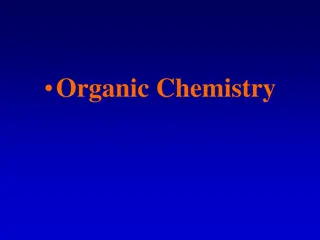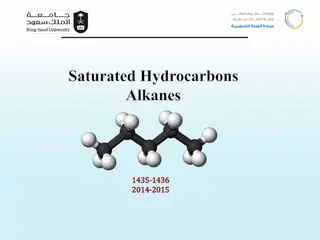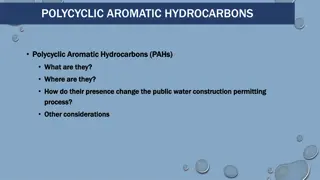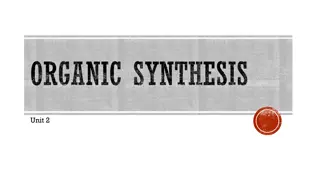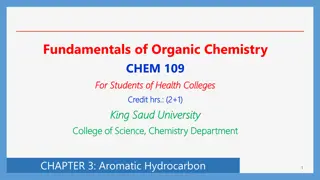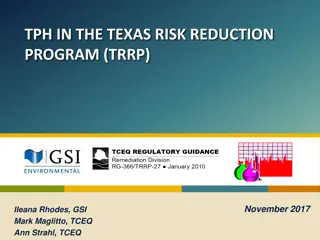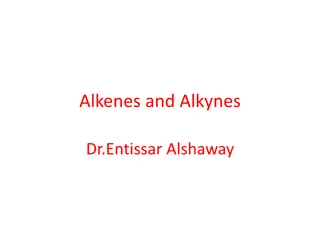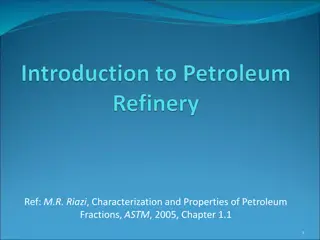Introduction to Alkanes and Hydrocarbons
This content covers the classification, formulas, structural representations, naming rules, physical properties, preparation methods, reactions, and special characteristics of alkanes, as well as the classification of hydrocarbons and atomic orbitals. Learn about primary, secondary, and tertiary carbons, hybridization of carbon in alkanes, and more.
Download Presentation

Please find below an Image/Link to download the presentation.
The content on the website is provided AS IS for your information and personal use only. It may not be sold, licensed, or shared on other websites without obtaining consent from the author.If you encounter any issues during the download, it is possible that the publisher has removed the file from their server.
You are allowed to download the files provided on this website for personal or commercial use, subject to the condition that they are used lawfully. All files are the property of their respective owners.
The content on the website is provided AS IS for your information and personal use only. It may not be sold, licensed, or shared on other websites without obtaining consent from the author.
E N D
Presentation Transcript
Saturated Hydrocarbons Alkanes Dr. Shatha I Alaqeel 1 108 Chem
Learning Objectives Chapter one discusses the following topics and the student by the end of this chapter will: Know the classification of hydrocarbon Know general formula of simple alkanes and their names from methane to decane. Know the different methods of representing molecular formulas Know the different classes of carbon and hydrogen atoms know the hybridization and geometry of alkanes Know the rules for naming branched chain alkanes and how to use them. Know the physical properties of alkanes and factors affecting them. Know the different methods used for preparing alkanes Know the different reaction of alkanes. Know why are cycloalkanes are special class of hydrocarbons Know the cis/trans isomerism in cycloalkanes Know the rules for naming cycloalkanes and how to use them. know the halogenation reactions of different cycloalkanes. 2 108 Chem
Hydrocarbons ( C,H) Unsaturated Saturated i.e. contain only single bonds i.e. contain multiple bonds (double or triple) Cyclic e.g. Cycloalkanes Opened chain e.g. Alkanes Cyclic e.g. Cycloalkenes and Aromatic compouds Opened chain e.g. Alkenes and Alkynes 3 108 Chem
Alkanes : CnH2n+2 Carbon 1 2 3 4 5 6 7 8 9 10 Name Methane Molecular Formula CH4 C2H6 C3H8 C4H10 C5H12 C6H14 C7H16 C8H18 C9H20 C10H22 Structural Formula CH4 CH3CH3 CH3CH2CH3 CH3CH2CH2CH3 CH3CH2CH2CH2CH CH3(CH2)4CH3 CH3(CH2)5CH3 CH3(CH2)6CH3 CH3(CH2)7CH3 CH3(CH2)8CH3 Ethane Propane Butane Pentane Hexane Heptane Octane Nonane Decane 4 108 Chem
Representation Of Molecular Formulae 5 108 Chem
Classes Of Carbons and Hydrogens Primary carbon 1 : CH3-CH2-CH3 Carbon bonded to only one other carbon Secondary carbon 2 : CH3-CH2-CH3 Carbon bonded to two other carbon Tertiary carbon 3 : (CH3)2-CH-CH3 Carbon bonded to three other carbon Hydrogens are also referred to as 1 , 2 or 3 according to the type of carbon they are bonded to. 6 108 Chem
ATOMIC ORBITALS is a specific region in space in which an electron is most like to be found S-Orbital P-Orbital d-Orbital 7 108 Chem
hybridization of carbon in alkane: In the case of a carbon that has 4 single bonds, all of the orbitals are hybrids 4 Molecular orbital (Sp3) Each orbital has 25% s, 75% p Character 8
In ALKANES, the four sp3 orbitals of carbon repel each TETRAHEDRAL arrangement with bond angles of 109.5 . C other into a Each sp3 orbital in carbon overlaps with the 1s orbital of a hydrogen atom to form a C-H bond. 109.5 9
s orbital (hydrogen) Ethane: bond 109.5 sp3 hybrids orbital (carbon) The length of the band: 1.54 A Angle: 109.5 10 108 Chem
Isomerism Isomers are different compounds with the same molecular formula Structural Isomers (Constitutional isomers) are Isomers that differ in their structures . 11 108 Chem
Geometrical compounds arrangement but different arrangement around a carbon-carbon double bond Isomers with (Stereoisomers) the same are covalent 12 108 Chem
Alkyl groups Alkyl groups are formed by loss of a hydrogen atom from the corresponding alkane ( e.g. CH4 Methane 1 H = -CH3 Methyl group ) Alkyl groups are named by dropping the -ane suffix of the alkanes and adding the suffix -yl. Methane becomes a methyl group, ethane an ethyl group, etc. 13 108 Chem
Propyl group C3H7 (can give two isomeric alky groups) CH3 CH3-CH2-CH2- CH3-CH Isopropyl n-Propyl Butyl Group C4H9 (can give four isomeric alky groups) n-butyl group isobutyl sec- butyl tert-butyl 14 108 Chem
IUPAC Nomenclature Of Branched-Chain Alkanes 1- Locate the longest continuous chain of carbon atoms; this chain determines the root name for the alkane. Sometimes, you may need to go around corners and zigzag to find the longest (parent) chain. (the parent chain is in blue): CH3 CH3 H C H C H3C CH CH2 CH3 CH3CH2CH2CH2CHCH3 CH3CH2CH2CH2CHCH3 H3C CH CH2 CH3 CH3CH2CH2CH2CHCH3 H2C CH2 CH3 H2C CH2 CH2 CH3 CH2 CH3 CH3 CH3 If the parent chain for example has 6 carbon atoms, therefore, it is a derivative of hexane and if it has 4 carbon atoms it is derivative of butane and so on. 15 108 Chem
2- Number the longest chain beginning with the end of the chain nearer to the substituent. Substituent 5 4 3 6 2 1 4 6 7 5 3 CH3CH2CH2CH2CHCH3 CH3CH2CH2CH2CHCH3 CH3 Substituent 2 CH2 CH3 1 16 108 Chem
3- Use the numbers obtained by application of rule 2 to designate the location of the substituent group. In writing the full name the root name is placed last; the substituent group, preceded by the number indicating its location on the chain, is placed first. 17 108 Chem
When two or more substituents are present, give each substituent a number corresponding to its location on the longest chain. The substituent groups are listed alphabetically regardless of their order of occurrence in the molecule. Cl is called chloro, Br called bromo, I called iodo, F called fluoro, NO2 called nitro, CN called cyano 18 108 Chem
5- When two or more substituents are identical, indicate this by the use of the prefixes di-, tri-, tetra-, and so on. In case of deciding alphabetical order of many substituent disregard multiplying prefixes such as di and tri , tetra , penta , . 19 108 Chem
6- When two substituents are present on the same carbon, use the number twice. CH3 H3CCH2 C CH2CH2CH3 CH2 CH3 3-Ethyl-3-methylhexane 20 108 Chem
When two chains of equal length compete for selection as the parent chain, choose the chain with the greater number of substituents. 21 108 Chem
8- When branching occurs at an equal distance from both ends of the longest chain, choose the name that gives the lower number at the first point of difference. 22 108 Chem
Important Notes The common names isopropyl, isobutyl, sec-butyl, tert-butyl are approved by the IUPAC for the substituted groups. Substituent groups are cited in the name in alphabetical order, regardless of their order of occurrence in the molecule. Multiplication prefixes di, tri, ect. and structural prefixes sec., tert. written in italics and separated from the name by a hyphen) are ignored, but prefixes iso and cyclo are not! Thus tert-butyl precedes ethyl , but ethyl preceeds isopropyl 3-ethyl comes before 2,2-dimethyl 4-hexyl comes before 2,3-diisopropyl 3-Tert-butyl comes before 3-isopropyl 23 108 Chem
Examples of The IUPAC Rules 7 5 7 5 1 1 9 9 4 6 2 4 3 3 8 10 2 10 6 8 6-tert-Butyl-2-methyl-decane 4-Isopropyl-3-methyl-decane 24 Thus the parent chain will be the one with 4 substituents and the correct IUPAc name of this compound is : 3-Ethyl-2,2,5-trimethylhexane 108 Chem
Physical Properties C1-C4 unbranchedalkanes are gases; the C5-C17 unbranched alkanes are liquids; the unbranched alkanes with 18 or more carbon atoms are solids. Alkanes are non- polar so are immiscible with water , they are soluble in most organic solvents. Boiling points and Melting points The boiling points and melting points of alkanes increase with increasing the numbers of carbon atoms and increasing molecular weights. Branching reduces the boiling point, the more branching leads to lower the boiling point. 25 108 Chem
Example 26 108 Chem
Preparation Of Alkanes 1- Hydrogenation of unsaturated hydrocarbon Ni or Pd or Pt / H2 H2 C CH2 H3 C CH3 200, 300 2- Hydrolysis of Grignard reagent Dry ether + Mg2+ CH3CH2MgBr CH3CH2Br Grignard reagent H3O+ CH3CH3 + 27 CH3CH2MgBr Mg(OH)Br 108 Chem
3- Reduction of alkyl halides a) By metal and acid or by metal hydrides H + Zn CH3CH2CH3 + ZnBr2 CH3CH2CH2Br 1) LiAlH4 / ether CH3CH2CH2CH2Br CH3CH2CH2CH3 2) H3O b) By sodium metal (Coupling reaction)(Wurtz reaction) + CH3 + H3 C Br H3 C 2 NaBr 2 Na 2 Symmetrical alkane c) By lithium dialkyl cuprate (Corey-House (Gilman reagent)) CH3 CH3 Li Cu (CH3CH2)2CuLi Cl Li 28 + (CH3CH2)2CuLi CH3CH2CH3 CH3Br 108 Chem
Reactions Of Alkanes Chemically alkanes are very unreactive and stable at room temperature towards acids , bases and most reactive metals. Despite their relative inertness ( thus they known as paraffines i.e lacking affinity) halogenation reactions. 1. Halogenation: Halogenation is the replacement of one ormore hydrogen atoms in an organic compound by a halogen (fluorine, chlorine, bromine or iodine). The halogenation of an alkane appears to be a simple free radical substitution reaction in which a C-H bond is broken and a new C-X bond is formed; the reaction takes place in presence of heat or UV light ( no reaction in the dark to form the attacking radicals) Heat or UV light , alkanes undergo 29 RH + X2 RX + HX X = Cl or Br Alkyl halide 108 Chem
UV Initiation step only radicals of halogen are formed 1) Cl Cl 2Cl HCl + CH3 methyl free radical + Cl H3C H Propagation step Formation of a product and a new radical 2) Cl Cl Cl chloride free radical + + CH3Cl CH3 Cl + Cl Cl-Cl CH3 + Cl CH3-Cl 3) Termination step Union of two radicals to form a molecule CH3 + CH3 CH3-CH3 Order of Stability of alkyl free radicals R R R H R R CH3 H 2o H 1o R 30 3o 108 Chem
If there is one type of the carbon atoms in the molecule (e.g. methane and ethane) H C H H UV light Cl2 H CH3Cl + CH2Cl2 + CHCl3 + CCl4 + 4HCl + or Heat excess If there are different types of carbon In the higher alkanes, replacment of different hydrogn atoms may lead to isomeric products. The preferred order for the hydrogens to be substituted is 3 then 2 then 1 . Br 2 1 1 UV light + Br + Br2 H3C CH3 H3C CH3 H3C CH2 or Heat Propane Major Minor 31 108 Chem
2. combustion of alkanes Alkanes are oxidized to carbon dioxide and water. CO2 +2 H2O +213 kcal/mol CH4 + 2 O2 2 CO2+3 H2O +373 kcal/mol C2H6 + 7/2 O2 32 108 Chem
Cycloalkanes Cycloalkanes are alkanes that have carbon atoms forming rings (called alicyclic compounds). Simple cycloalkanes have the formula (CH2)n, or CnH2n Nomenclature of Unsubstituted Cycloalkanes 1. Cycloalkanes with only one ring: Bond Angle 33 108 90 60 109.5 108 Chem Ring strain
Naming Substituted Cycloalkanes Count the number of carbon atoms in the ring and the number in the largest substituent chain. If the number of carbon atoms in the ring is equal to or greater than the number in the substituent, the compound is named as an alkyl-substituted cycloalkane i.e. use the prefix cyclo followed by the suffix indicate the number of carbon atoms. For an alkyl- or halo-substituted cycloalkane, start at a point of attachment as C1and number the substituents on the ring so that the second substituent has as low a number as possible. Number the substituents and write the name with the substituents in alphabetical order. 34 108 Chem
If the alkyl substituent is larger and/or complex, the ring is considered as a substituent on alkane chain. 1 3 CH2CH2CH2CH2CH3 2 1,3-Dicyclohexylpropane 1-cyclobutylpentane If a functional group (OH. CHO, COOH, CO , NH2) is attached to the ring a suitable suffix is used to indicate their presence as appear in the following examples. 35 108 Chem
36 108 Chem
Cis-Trans Isomerism In Cycloalkanes Rotation about C-C bonds in cycloalkanes is limited by the ring structure. There are two different isomers, one with the two methyls on the same side (cis) of the ring and one with the methyls on opposite sides (trans). 1,2-dimethylcyclopropane 37 108 Chem
Reactions Of Cycloalkanes Less stable rings More stable 5 and 6 rings CH3 CH3 Br Br2/UV or Heat 38 Cl Cl2/heat or UV 108 Chem
Thank You for your kind attention ! Questions 39 108 Chem
